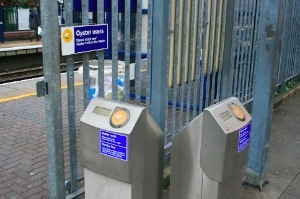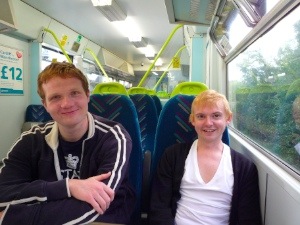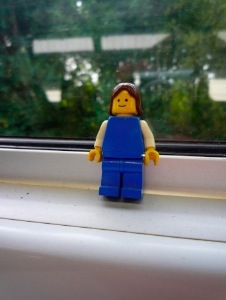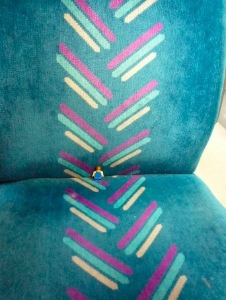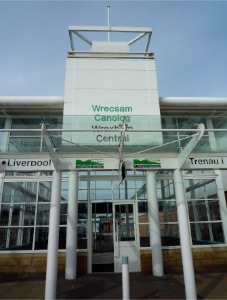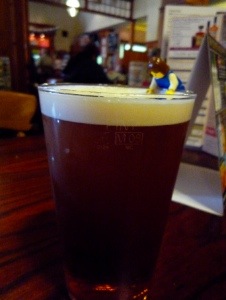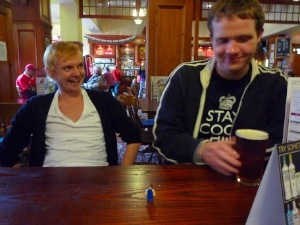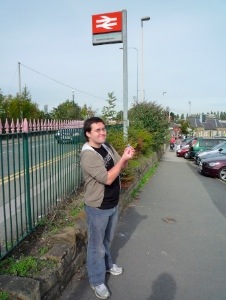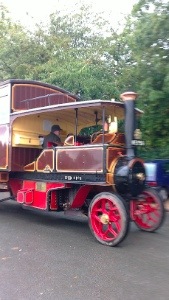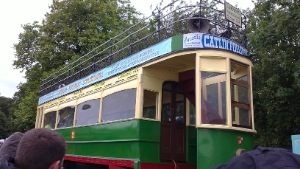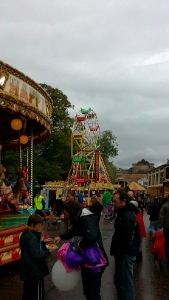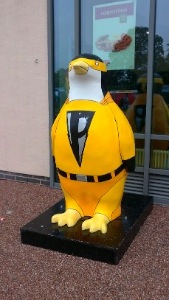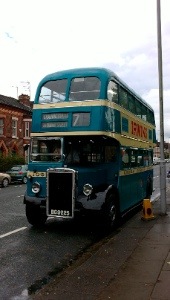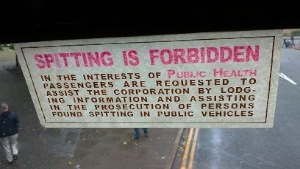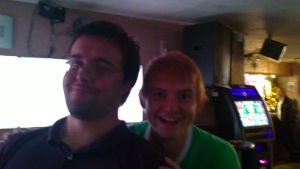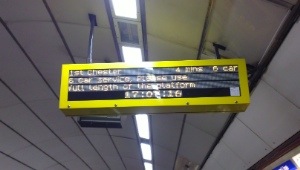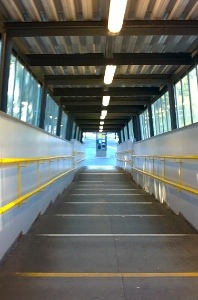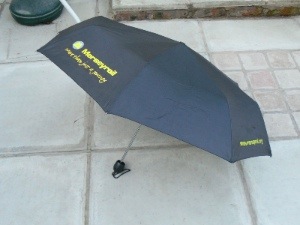Part two of a two part trip: for part one, click here.
Pedants will observe that Wrexham is not on the Merseyrail map. Well, not physically, anyway: it's mentioned in a box at the bottom. Furthermore, a quick scan down the page will reveal that this post is all about stations on the Borderlands Line which are also not on the Merseyrail map. These pedants will therefore be frothing at their mouths, demanding a justification for this heinous act.
My justification actually comes in four parts:
1) Doing only part of the Borderlands Line never felt right. Since it's such a simple, single route, with trains shuttling back and forth, it feels like a self-contained route, so stopping at Shotton and saying "well, that's that done" seemed like I was short changing it.
2) One day, someday, maybe, it will be part of the Merseyrail family as an extension to the Wirral Line. Possibly.
3) In the comments to this piece, an "Anonymous" commenter suggested I should do every place that's mentioned on the Merseyrail map - in other words, include the little arrows on the edge as well. I kind of like that idea, though of course, it's a tentative thing. It's easy for me to "do" North Wales. Glasgow, less so. I'm mulling it over.
4) It's my blog and if you don't like it, tough.
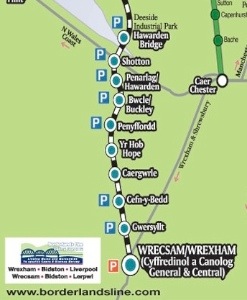 Sorry for the truly dreadful map. You should see the whole thing: it's an abomination.
Sorry for the truly dreadful map. You should see the whole thing: it's an abomination.
With Wrexham under our belts, Roy, Robert and I headed out of town on the Arriva train to Gwersyllt, a station on its way out of the borough. We were - after much agonies - using a North Wales Rover ticket. To be honest, I didn't have any agony buying it at all, but poor Roy spent forty minutes at Waterloo station trying to convince the staff there that it existed, and that he could buy it from them. They finally concluded that they couldn't sell him any Rover tickets, and sent him away with a flea in his ear.
Roy next went to Lime Street Mainline, who'd also never heard of it. They at least called Chester to enquire about it, but they hadn't heard of it either, so in the end Roy just jumped on a train to Bidston to meet Robert and me. Surely the staff at Bidston could sell it to us? Erm, no. Apparently not.
What to do? The North Wales Rover covered two zones, Flintshire and Wrexham, giving us unlimited train journeys and even bus trips if we got tired. But no-one seemed to want to sell it to us. Robert came up with a plan: accost the conductor on the train and see if we could buy it off him.
"Can we have three North Wales Rover tickets please?"
"Yup." A couple of taps on his touchscreen, and three paper tickets slid out into our palms. Chalk one up to Arriva Trains Wales.
We got off at Gwersyllt which, like the rest of the line, is unstaffed and undistinguished. The station's over the road from a Lidl, and will never win any prizes for beauty or elegance. As we got off, a long-lost member of the Goldie Looking Chain decided to get off too, with his best swagger in his trackies.
 Gwersyllt does at least have a big prominent sign. This would be an increasingly rare sight as the day went on.
Gwersyllt does at least have a big prominent sign. This would be an increasingly rare sight as the day went on.
From there it was a wander down a dual carriageway to get to our next stop. Summer was having one last gasp for air; it was officially the first day of autumn, but it was the closest thing to August we'd had in weeks. There were still berries on the trees and flowers in the gardens, and a gang of road workers were cutting the grass in the central reservation, filling the air with that just mown scent.
(Incidentally, a quick tip for Wrexham CBC: you could save a bomb on your road maintenance costs if you sent out just a couple of men to mow the verge, instead of the seven we saw. And if you gave them decent lawnmowers, instead of strimmers).
 The road narrowed to a bridge and we crossed over into Flintshire or, as it is in Welsh, Sir y Fflint. We were headed for Cefn-y-bedd, which lead to a discussion amongst us three Englishmen as to (a) how you pronounced it and (b) what it means. Since our debate was getting us nowhere, I gave in and called the Bf, who grew up in North Wales and so knew this kind of thing. According to his linguistic prowess, Cefn-y-bedd translates as "Rear The Grave". And he pretends he's a Scouser.
The road narrowed to a bridge and we crossed over into Flintshire or, as it is in Welsh, Sir y Fflint. We were headed for Cefn-y-bedd, which lead to a discussion amongst us three Englishmen as to (a) how you pronounced it and (b) what it means. Since our debate was getting us nowhere, I gave in and called the Bf, who grew up in North Wales and so knew this kind of thing. According to his linguistic prowess, Cefn-y-bedd translates as "Rear The Grave". And he pretends he's a Scouser.
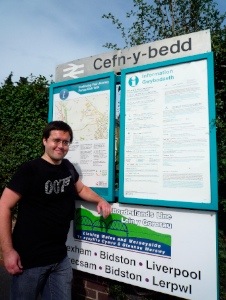 Rear The Grave turned out to be a pretty little village, with a large pub about five minutes walk from the station. Roy - whose drinking habits make me look like a teetotal nun - advocated we go there for another pint, but as there was only fifteen minutes till the next train, we settled into the shelter on the platform instead.
Rear The Grave turned out to be a pretty little village, with a large pub about five minutes walk from the station. Roy - whose drinking habits make me look like a teetotal nun - advocated we go there for another pint, but as there was only fifteen minutes till the next train, we settled into the shelter on the platform instead.
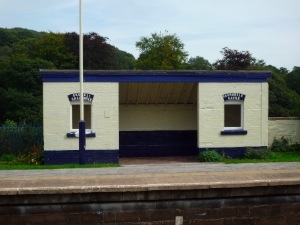 Caergwrle used to be called Caergwrle Castle & Wells, until sanity prevailed sometime in the mid Seventies. The pretty little shelter on the platform still had this name painted over a very deep blue that was certainly not Arriva Trains colours: I predict a truck with a couple of gallons of emulsion is on its way even as we speak.
Caergwrle used to be called Caergwrle Castle & Wells, until sanity prevailed sometime in the mid Seventies. The pretty little shelter on the platform still had this name painted over a very deep blue that was certainly not Arriva Trains colours: I predict a truck with a couple of gallons of emulsion is on its way even as we speak.
The station also provided another mystery: what is "Chester on Tour"?
 These stickers had been applied to a few of the stations along the way - I'm guessing it's something to do with the football team, but I'd be happy to be proved otherwise.
These stickers had been applied to a few of the stations along the way - I'm guessing it's something to do with the football team, but I'd be happy to be proved otherwise.
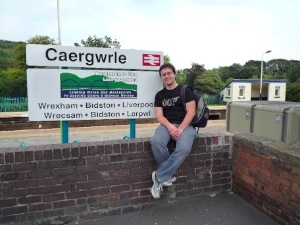 Sign snapped, we continued to Hope, along a route that was far more scenic than our previous one. The trees were thick and overhanging here, and the traffic was light. The houses were also a charming mix of nineteenth century and older cottages, threaded along green streets. The road took us over a pretty weir, and we all stopped to admire it.
Sign snapped, we continued to Hope, along a route that was far more scenic than our previous one. The trees were thick and overhanging here, and the traffic was light. The houses were also a charming mix of nineteenth century and older cottages, threaded along green streets. The road took us over a pretty weir, and we all stopped to admire it.
 It was lovely, but I wondered how long I'd be able to live here before I cracked and went insane with a pitchfork? I see the countryside as something to be viewed from a distance, on a day trip. Once you start getting immersed in it, and are living in it, you realise the reason that it's all so pretty is there's nothing there. I'd be driven mad if I had to get in a car every time I wanted to buy a magazine or something non-essential. And what do you do when your home is attacked by armed thugs, who break in and hold you hostage? You can't call for help, because no-one will hear you. (Of course, in the city, they'll hear your cries and ignore them because it's none of their business, but that's not the point). I don't want my last few moments to be spent trussed up on a folding chair while thieves ransack my home willy-nilly, free to romp as long as they like because there's not even a street light outside.
It was lovely, but I wondered how long I'd be able to live here before I cracked and went insane with a pitchfork? I see the countryside as something to be viewed from a distance, on a day trip. Once you start getting immersed in it, and are living in it, you realise the reason that it's all so pretty is there's nothing there. I'd be driven mad if I had to get in a car every time I wanted to buy a magazine or something non-essential. And what do you do when your home is attacked by armed thugs, who break in and hold you hostage? You can't call for help, because no-one will hear you. (Of course, in the city, they'll hear your cries and ignore them because it's none of their business, but that's not the point). I don't want my last few moments to be spent trussed up on a folding chair while thieves ransack my home willy-nilly, free to romp as long as they like because there's not even a street light outside.
This discussion took us into Hope, which, besides having a lovely name, also does well as a village. Tiny chip shop, tiny dressmaker, tiny garage, a church and two pubs - compared to Cefn-y-Bedd, this was a throbbing metropolis. We had loads of time before our train so we picked the Red Lion at random and went in.
I'd now like to apologise to the landlady of the Red Lion. The three of us relentlessly leered, lusted after and perved at your barman son, who was incredibly fit and wearing shorts. We made a number of comments that would have made Samantha from Sex and the City blush, mostly involving him being stripped naked and spreadeagled over a bar stool. It was a thoroughly shameful display of objectification and we should have been more discreet and polite.
On the other hand, it cost £9.50 for a pint of John Smiths, two pints of Stella and a packet of Quavers, so I think we can safely say you've had adequate compensation.
Once we'd drunk our drinks, and adjusted our underwear, we headed for the station. Sort of. What's going on, Hope? Why don't you want to put up signs for your train station? Are you ashamed of it?
I lead the way, brandishing an Ordnance Survey map and mentally tying my compass to it. Roy and Robert were less convinced as we headed down into a cul-de-sac, with plain semi-detatched houses on either side. In fact, they began to openly pour scorn on my directions. I suspect they secretly hoped I was wrong, so we could miss our train and go back to the pub for another session of Fantasy Barman, but I knew I was right. I just knew it. There wasn't a doubt in my mind. Ok, maybe a little one.
 That's why I look a bit smug in that photo.
That's why I look a bit smug in that photo.
To be fair, the station was really hidden away: if you didn't know it was there, you would never find it. And as I've said, Hope was a pretty large village - there are loads of potential passengers there.
Back on the train, and thankfully the ticket inspector wasn't the same one who'd sold us ours that morning. It was starting to get embarrassing, running into him over and over.
Off at the delightfully named and consonant heavy Pen-y-ffordd station. It looked a bit prettier than some of the other Borderlands stations, and we found out why: it's been adopted.
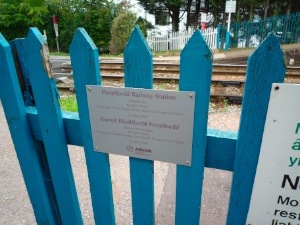 Kudos to you, Richard Spray, and your horticultural efforts.
Kudos to you, Richard Spray, and your horticultural efforts.
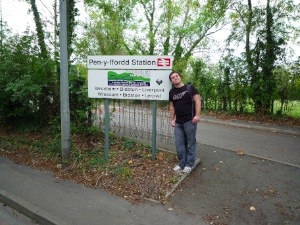 The route from Pen-y-ffordd to our next stop, Buckley, was colossally dull. We were all starting to flag a bit by this point, with the beers and the walking taking their tolls on us. My foot, which is well on its way to being fully healed, was also starting to make its presence felt in my trainer, throbbing slightly. It wasn't in the mood to trudge alongside a bypass, on soft grass because there was no pavement, with nothing to look at. Not a thing. There was the occasional horse in a field, but that was it. Beyond that it was just one long slog. The weather was turning on us, too, and the skies were greying over.
The route from Pen-y-ffordd to our next stop, Buckley, was colossally dull. We were all starting to flag a bit by this point, with the beers and the walking taking their tolls on us. My foot, which is well on its way to being fully healed, was also starting to make its presence felt in my trainer, throbbing slightly. It wasn't in the mood to trudge alongside a bypass, on soft grass because there was no pavement, with nothing to look at. Not a thing. There was the occasional horse in a field, but that was it. Beyond that it was just one long slog. The weather was turning on us, too, and the skies were greying over.
We talked on the way about the Borderlands Line, and its future. Before we travelled on it, we'd all been quite gung-ho. Bring it into Merseyrail! Get it on the map! Having almost completed it, we found ourselves asking - why? Because what struck us was how different the Borderlands Line was to Merseyrail. Unstaffed, deserted stations in tiny villages. Barrow crossings. No kind of customer services. How different it was to the very urban stations we were used to.
Getting Merseyrail to Wrexham - yes, absolutely, I can see that is a valid target. Especially as Wrexham General becomes more and more important. But when they electrified all the way to Chester, it meant they also got the urban sprawl of the Wirral in on the act too, places like Bromborough and Spital, dense urban environments. How many people would use a frequent service in Cefn-y-bedd? How many passengers would get on at Hope for the hour long journey to Liverpool?
The more we travelled on it, the more it seemed like the Borderlands Line would be a bad fit with Merseyrail. I can absolutely get on board with an extension to Woodchurch; possibly even as far as Neston or Shotton. But beyond there, it's a lot of rural halts that would just get in the way. It seems less like a business plan, and more like someone colouring in the lines on the map.
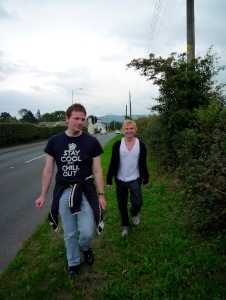 As for Buckley station - well, it's a liar. It's nowhere near Buckley, which is another minus point for electrification. It should be called Little Mountain, because that's where it is, and besides, that's a much better name.
As for Buckley station - well, it's a liar. It's nowhere near Buckley, which is another minus point for electrification. It should be called Little Mountain, because that's where it is, and besides, that's a much better name.
The train was late at Buckley, by twenty minutes. Robert was able to bring up the National Rail update on his phone while we huddled in the shelter from the newly arrived rain. We were accompanied in the shelter by two teenagers, who were both listening to their iPods way too loudly, causing a competing mash-up of discordant sounds. I couldn't work out what they were listening to: from this distance it sounded like half a dozen keyboards being thrown into a grinder. I'm getting old. What's wrong with a bit of Blur, eh, kids?
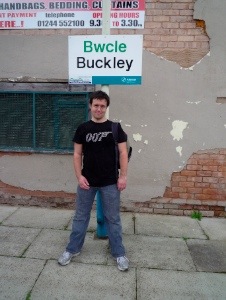 They gave us some very odd looks as we took our photos too. They didn't say anything though. If they were in Merseyside they'd have been all over us, demanding to know what we were up to, but in rural Wales they've been brought up better.
They gave us some very odd looks as we took our photos too. They didn't say anything though. If they were in Merseyside they'd have been all over us, demanding to know what we were up to, but in rural Wales they've been brought up better.
Only one station remained to be tarted on the Borderlands Line, and that was Hawarden. We'd debated whether to walk from Hawarden to Shotton to finish with, but decided that it'd be better to stay there and get a pint and a pub meal. We'd been walking for hours, and the soulless trip to Buckley had taken out our last bit of enthusiasm.
This is not to denigrate Hawarden station in any way. It was lovely. Lots of planters, freshly painted, murals in the shelters - all very nice. It even had a footbridge over the tracks, instead of making you cross the line itself. Once again, we have someone to thank: Mr John Wannop.
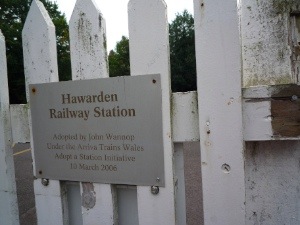 Since it was the last station of the day, we went for a group shot, which unfortunately blocks out the English translation for us foreign types:
Since it was the last station of the day, we went for a group shot, which unfortunately blocks out the English translation for us foreign types:
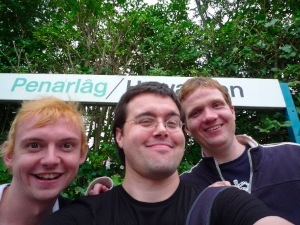 But here's me and the translation, just for completion's sake:
But here's me and the translation, just for completion's sake:
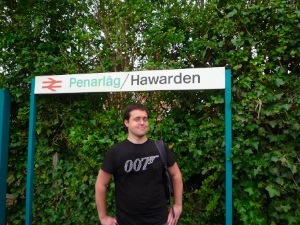 Incidentally, how do you pronounce Hawarden? All three of us pronounced it "Hard-on", leading to many base jokes and schoolboy sniggers. But the announcer at Wrexham pronounced the middle syllable - "Ha-warden" - and quite spoiling our fun. That doesn't sound even slightly smutty. Maybe it's part of a concerted effort by the locals to remove the innuendo, like when everyone started pronouncing "Uranus" differently.
Incidentally, how do you pronounce Hawarden? All three of us pronounced it "Hard-on", leading to many base jokes and schoolboy sniggers. But the announcer at Wrexham pronounced the middle syllable - "Ha-warden" - and quite spoiling our fun. That doesn't sound even slightly smutty. Maybe it's part of a concerted effort by the locals to remove the innuendo, like when everyone started pronouncing "Uranus" differently.
You've probably heard of Hawarden; it's quite a notable town in North Wales, and it's worth visiting. It's famous for being the home of Michael Owen, who bought up an entire close for his family after he hit the big time. He himself lives in a manor outside the village. We considered nipping in for a hello, but there wasn't really time. Plus we thought we'd get shot.
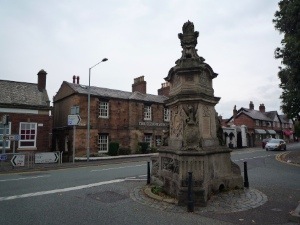 Instead we hit the pub for that pint and meal. You'd have to be on a footballer's wages round here to afford the beer: £9.10 for a pint of John Smiths and two Stellas? The Red Lion was forty pence more, and that included a pack of Quavers. Plus, it turned out that they didn't serve food until 5:30, despite there being a sandwich board outside and menus on the table. And if that wasn't bad enough, there were no fit barmen, only two young girls in low-cut tops. Who wants to see that? (Oh you do, do you?). We got up and left. Hang your head in shame, Fox & Grapes.
Instead we hit the pub for that pint and meal. You'd have to be on a footballer's wages round here to afford the beer: £9.10 for a pint of John Smiths and two Stellas? The Red Lion was forty pence more, and that included a pack of Quavers. Plus, it turned out that they didn't serve food until 5:30, despite there being a sandwich board outside and menus on the table. And if that wasn't bad enough, there were no fit barmen, only two young girls in low-cut tops. Who wants to see that? (Oh you do, do you?). We got up and left. Hang your head in shame, Fox & Grapes.
There were other pubs, but to be honest, we were all exhausted, and running out of money (there are no cash machines in Hawarden! What do they do, barter?). Stuff it we thought: we'll go home.
 We'd earned it, after all. Six hours of trekking through North Wales, following the Borderlands over the border and back. It was finally time to say goodbye to this strange little anachronistic line, this commuter route that isn't, this country train that goes to the city. I've crossed it off the map now, and I can feel a sense of completion.
We'd earned it, after all. Six hours of trekking through North Wales, following the Borderlands over the border and back. It was finally time to say goodbye to this strange little anachronistic line, this commuter route that isn't, this country train that goes to the city. I've crossed it off the map now, and I can feel a sense of completion.
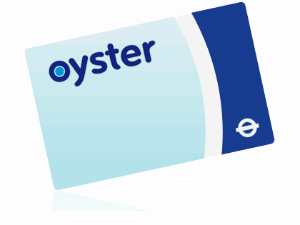 Here's a tip: go to London. Every time I swoosh an Oyster card, I feel a little thrill of excitement at the genius technology of it. A wave of a piece of plastic, and the gates spring open for me; the correct fare is deducted, and the computer keeps track of how much I've spent to make sure I don't pay too much. If there's not enough money on the card, it contacts my bank and transfers some funds across. In split second, lightning fast time. It's so efficient, seamless and, well, futuristic, I've been desperate for it to be rolled out across the rest of the country.
Here's a tip: go to London. Every time I swoosh an Oyster card, I feel a little thrill of excitement at the genius technology of it. A wave of a piece of plastic, and the gates spring open for me; the correct fare is deducted, and the computer keeps track of how much I've spent to make sure I don't pay too much. If there's not enough money on the card, it contacts my bank and transfers some funds across. In split second, lightning fast time. It's so efficient, seamless and, well, futuristic, I've been desperate for it to be rolled out across the rest of the country.